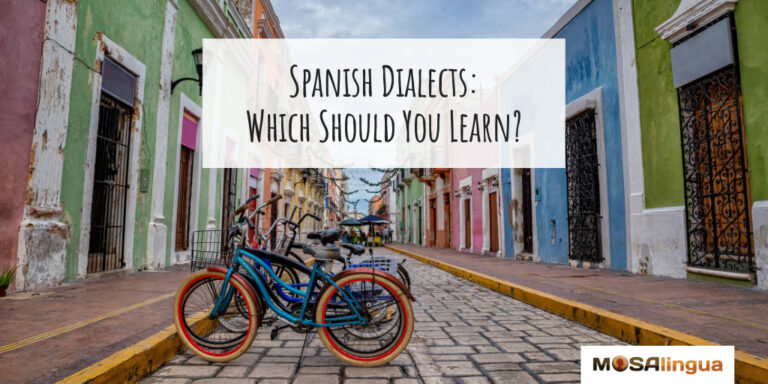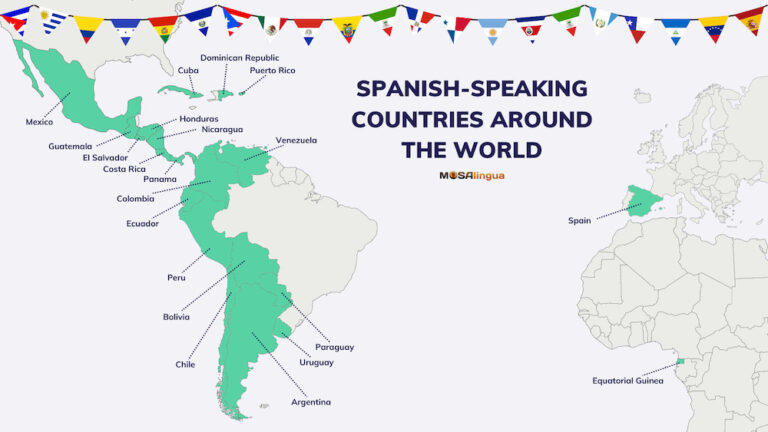Which Spanish should I learn? If you’re considering learning Spanish, or have just started – have you asked yourself this important question yet? It might seem so simple that you haven’t taken the time to really think about it. Or maybe you’re aware that there are differences in Spanish dialects but don’t really know what they are. The good news is that there is no wrong answer! But there is a best answer for each learner, and that depends on a variety of factors. We’ll cover some important points to consider when answering this question, plus some of the main differences between varieties of Spanish.

The Spanish Dialect Debate: Which Spanish Should I Learn?
If you’re trying to decide what type of Spanish to learn, this article will help you make up your mind! And if you’d rather learn about this topic via video, skip to the bottom of the page for one that our Spanish instructor Mirari recorded for you. ¡Vamos allá!
Differences in the Many Varieties of Spanish
Much like English, there exist many varieties of Spanish spoken around the world. These vary based on region (for example, Spain vs. Latin America), country (like Mexico vs. Colombia), and even city or the speaker’s socioeconomic status.
Just check out this map that shows all the places in the world where Spanish is spoken as a native language:
Just like English, Spanish varieties are always mutually intelligible. If a Spanish person travels to Mexico, they should have no problem understanding or making themselves understood.
Good news, right? 😉 (This isn’t always the case. Take Arabic, for example.)
As a learner, however, the main decision generally comes down to choosing between European Spanish (that is, Spanish from Spain) and Latin American Spanish. Generally speaking, Americans choose to focus on Latin American Spanish, and Europeans on Iberian Spanish (also called Peninsular Spanish).
But how big are the differences?
Imagine the difference between British English and American English. There are clear differences in vocabulary and pronunciation, but the grammar is mostly the same.
Does that go for European and Latin American Spanish, too? Let’s have a look at some of the main differences between these varieties.
2nd person pronoun: Tú vs Usted
Unlike English, in Spanish, there are different pronouns for “you” and “you all.”
In both Spain and Latin America, the informal tú is predominantly used for the second person singular. Usted is also used, but only when speaking to someone on a formal basis, for example, in a job interview or when addressing older generations.
For the second person plural in Spain, you’d use the informal vosotros and, again, ustedes is only used in formal conversations.
But in Latin America, ustedes is often used in both formal and informal conversations.
The singular pronoun vos is used in some parts of Latin America (Argentina, Uruguay, and Nicaragua, among other countries) instead of tú.
If you’re just starting to learn Spanish, sticking with the tú form will do just fine.
And here’s more good news: vos only conjugates differently in the present tense. Past and future are exactly the same, as with tú.
Improve your spoken Spanish

Good news: we have a course for that! The Speak Spanish with Confidence MasterClass.
It’s a comprehensive 8-module course designed to help you improve every aspect of your spoken Spanish – fluency, confidence, pronunciation, and more – step by step, and enjoy doing it.
Vocabulary
Yes, there are some Spanish words that are different in different countries. This can be the most frustrating difference for learners and is likely to cause minor communication issues.
- One very common example is the word coche, which means “car” in Spain. In most Latin American countries, they use carro instead.
- Potatoes are called patatas in European Spanish and papas in Latin American Spanish.
- T-shirt translates to camiseta in Spain, but to polera in Chile, remera in Argentina, playera in Mexico, and franela in Venezuela.
- And the last example: coger. You should be extra careful with this word when talking to a Latin American speaker. While it’s a synonym of tomar (to take) in Spain, on the other side of the Atlantic Ocean it means to have sex. 😳
While this can sometimes be confusing, it probably won’t hinder your overall understanding if you’re fluent enough to catch the context of a conversation. If you travel to Spain and ask for “un jugo de naranja” instead of “un zumo de naranja,” you’ll still get your orange juice in the end. Promise!
Pronunciation
One of the most iconic differences between Latin American and European Spanish is how certain letters are pronounced.
The most famous example? The Iberian Spanish “lisped” z sound.
While these differences won’t cause any misunderstanding, they can be a really clear mark of where you learned your Spanish.
Take a look at this example:
The letter “c” in cielo and the letter “z” in azul would make a “th” sound in Spain. You would hear: “el thielo eth athul.” In Latin America, you would hear a simple “s” sound for all of them: “el sielo es asul.”
The same difference applies to words like zapatos, cinco, or cerveza, among others.
Another letter that makes a different sound in Spain and Latin America is the double L.
In Spain and most of South America, you’d make the same sound as the letter Y in words like “buy,” “pay,” or “stay.” So lluvia will sound like “yuvia“; cuchillo like “cuchiyo“; and toalla like “toaya.” In certain parts of South America, especially in Colombia and Venezuela, you can hear the same LL pronounced like you’d pronounce a J in English: “juvia” or “jorar.” Finally, in Argentina and Uruguay, the LL will make a different sound, similar to the English “SH”: “shuvia,” “shave,” “cabasho.”
If you want to take a closer look at Spanish pronunciation, check out our video about the different Spanish accents.
Our Advice? Consider Your Destination
As mentioned earlier, despite differences in grammar, vocabulary, and accents, you’ll still be learning mutually understandable Spanish no matter where you study.
So if you’re still not sure about which variety to choose, you may need to consider other factors like your budget and learning purpose, for example. This may be a no-brainer, but figuring out how you want to use your Spanish can be very helpful.
For example, if you’re a U.S. business manager and want to expand your market to Spanish-speaking clients, you may want to choose a destination in Latin America. Not only will the vocabulary be better adapted, but understanding the culture of your target audience is also very important.
Conclusions: Which Spanish Should I Learn?
If you’re a beginner, our answer is “it doesn’t matter…” because despite these differences in variations of Spanish, 95% of what you’ll be learning will be the same.
However, if you’ve learned Spanish to a high level in either Spain or Latin America and then switch gears and drop yourself in a totally different country, there may be some friction in communication, at least at the beginning.
There are differences between varieties of Spanish, and if you know you’ll be spending your time in one particular country it makes sense to focus on that region’s Spanish from the start.
And… one last tip: if possible, expose yourself to different accents and varieties as early as you can so you can start to understand and appreciate the differences.
Bonus Video: Spain or Latin America: Which Spanish Should I Learn?
No time to read? No worries. Watch Mirari’s video about Spanish dialects to learn all you need to know. Mirari speaks in English in this video, but you can turn on subtitles in Spanish, French, Italian, Portuguese, and German if you need them! You can also slow down the playback speed by clicking on the Settings gear at the bottom right.
Don’t forget to subscribe to our YouTube channel!
Next Steps
If you enjoyed this article about Spanish dialects, you might also like:
- 12 Unique Facts About the Spanish Alphabet
- Is Spanish Easy for English Speakers to Learn?
- How to Order Food in Spain Like a Pro
- Common Spanish Mistakes That Make You Look Like an Amateur [VIDEO]





Comments